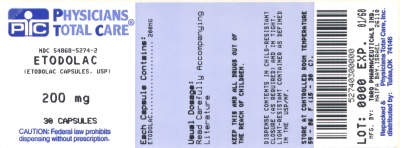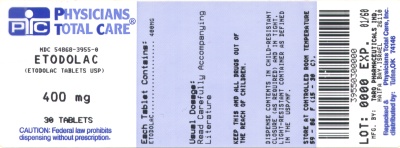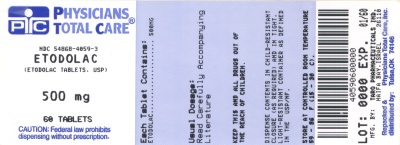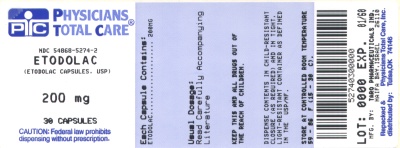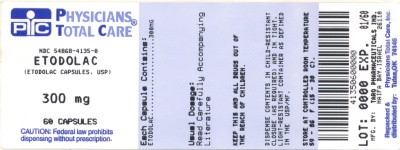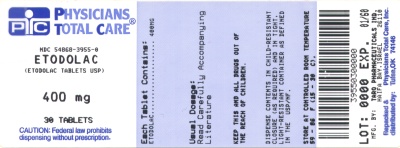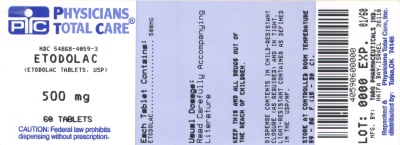GeneralEtodolac capsules and tablets, USP cannot be expected to
- substitute for corticosteroids or to treat corticosteroid insufficiency. Abrupt
- discontinuation of corticosteroids may lead to ...
General
Etodolac capsules and tablets, USP cannot be expected to
substitute for corticosteroids or to treat corticosteroid insufficiency. Abrupt
discontinuation of corticosteroids may lead to disease exacerbation. Patients on
prolonged corticosteroid therapy should have their therapy tapered solely if a
decision is made to discontinue corticosteroids.
The pharmacological activity of etodolac capsules and tablets, USP in
reducing fever and inflammation may diminish the utility of these diagnostic
signs in detecting complications of presumed noninfectious, painful
conditions.
Hepatic Effects
Borderline elevations of one or more liver tests may occur in up
to 15% of patients taking NSAIDs including etodolac capsules and tablets, USP.
These laboratory abnormalities may progress, may remain unchanged, or may be
transient with continuing therapy. Notable elevations of ALT or AST
(approximately three or more times the upper limit of normal) have been reported
in approximately 1% of patients in clinical trials with NSAIDs. In addition,
rare cases of severe hepatic reactions, including jaundice and fatal fulminant
hepatitis, liver necrosis and hepatic failure, some of them with fatal outcomes,
have been reported.
A patient with symptoms and/or signs suggesting liver dysfunction, or in whom
an abnormal liver test has occurred, should be evaluated for evidence of the
development of a more severe hepatic reaction while on therapy with etodolac. If
clinical signs and symptoms consistent with liver disease develop, or if
systemic manifestations occur (e.g., eosinophilia, rash, etc.), etodolac
capsules and tablets, USP should be discontinued.
Hematological Effects
Anemia is sometimes seen in patients receiving NSAIDs including
etodolac capsules and tablets, USP. This may be due to fluid retention, occult
or gross GI blood loss, or an incompletely described effect upon erythropoiesis.
Patients on long-term treatment with NSAIDs, including etodolac capsules and
tablets, USP, should have their hemoglobin or hematocrit checked if they exhibit
any signs or symptoms of anemia.
NSAIDs inhibit platelet aggregation and have been shown to prolong bleeding
time in some patients. Unlike aspirin, their effect on platelet function is
quantitatively less, of shorter duration, and reversible. Patients receiving
etodolac capsules and tablets, USP, who may be adversely affected by alterations
in platelet function, such as those with coagulation disorders or patients
receiving anticoagulants, should be carefully monitored.
Pre-existing Asthma
Patients with asthma may have aspirin-sensitive asthma. The use
of aspirin in patients with aspirin-sensitive asthmas has been associated with
severe bronchospasm which can be fatal. Since cross reactivity, including
bronchospasm, between aspirin and other nonsteroidal anti-inflammatory drugs has
been reported in such aspirin-sensitive patients, etodolac capsules and tablets,
USP should not be administered to patients with this form of aspirin sensitivity
and should be used with caution in all patients with pre-existing asthma.
Information for Patients
Patients should be informed of the following
information before initiating therapy with an NSAID and periodically during the
course of ongoing therapy. Patients should also be encouraged to read the NSAID
Medication Guide that accompanies each prescription dispensed.
- Etodolac capsules and tablets, USP, like other NSAIDs, may cause serious CV
side effects, such as MI or stroke, which may result in hospitalization and even
death. Although serious CV events can occur without warning symptoms, patients
should be alert for the signs and symptoms of chest pain, shortness of breath,
weakness, slurring of speech, and should ask for medical advice when observing
any indicative sign or symptoms. Patients should be apprised of the importance
of this follow-up (see WARNINGS,
Cardiovascular Effects).
- Etodolac capsules and tablets, USP, like other NSAIDs, can cause GI
discomfort and, rarely, serious GI side effects, such as ulcers and bleeding,
which may result in hospitalization and even death. Although serious GI tract
ulcerations and bleeding can occur without warning symptoms, patients should be
alert for the signs and symptoms of ulcerations and bleeding, and should ask for
medical advice when observing any indicative sign or symptoms including
epigastric pain, dyspepsia, melena, and hematemesis. Patients should be apprised
of the importance of this follow-up (see WARNINGS, Gastrointestinal Effects - Risk of Ulceration,
Bleeding, and Perforation).
- Etodolac capsules and tablets, USP, like other NSAIDs, can cause serious
skin side effects such as exfoliative dermatitis, SJS, and TEN, which may result
in hospitalizations and even death. Although serious skin reactions may occur
without warning, patients should be alert for the signs and symptoms of skin
rash and blisters, fever, or other signs of hypersensitivity such as itching,
and should ask for medical advice when observing any indicative signs or
symptoms. Patients should be advised to stop the drug immediately if they
develop any type of rash and contact their physicians as soon as possible.
- Patients should promptly report signs or symptoms of unexplained weight gain
or edema to their physicians.
- Patients should be informed of the warning signs and symptoms of
hepatotoxicity (e.g., nausea, fatigue, lethargy, pruritus, jaundice, right upper
quadrant tenderness, and "flu-like" symptoms). If these occur, patients should
be instructed to stop therapy and seek immediate medical therapy.
- Patients should be informed of the signs of an anaphylactoid reaction (e.g.
difficulty breathing, swelling of the face or throat). If these occur, patients
should be instructed to seek immediate emergency help (see WARNINGS).
- In late pregnancy, the third trimester, as with other NSAIDs, etodolac
capsules and tablets, USP should be avoided because they may cause premature
closure of the ductus arteriosus.
Laboratory Tests
Because serious GI tract ulcerations and bleeding can occur
without warning symptoms, physicians should monitor for signs or symptoms of GI
bleeding. Patients on long-term treatment with NSAIDs should have their CBC and
a chemistry profile checked periodically for signs or symptoms of anemia.
Appropriate measures should be taken in case such signs of anemia occur. If
clinical signs and symptoms consistent with liver or renal disease develop,
systemic manifestations occur (e.g., eosinophilia, rash, etc.) or if abnormal
liver tests persist or worsen, etodolac capsules and tablets, USP should be
discontinued.
Drug Interactions
ACE-inhibitors
Reports suggest that NSAIDs may diminish the antihypertensive
effect of ACE-inhibitors. This interaction should be given consideration in
patients taking NSAIDs concomitantly with ACE-inhibitors (see WARNINGS).
Antacids
The concomitant administration of antacids has no apparent effect
on the extent of absorption of etodolac capsules and tablets, USP. However,
antacids can decrease the peak concentration reached by 15% to 20% but have no
detectable effect on the time-to-peak.
Aspirin
When etodolac capsules and tablets, USP is administered with
aspirin, its protein binding is reduced, although the clearance of free etodolac
is not altered. The clinical significance of this interaction is not known;
however, as with other NSAIDs, concomitant administration of etodolac and
aspirin is not generally recommended because of the potential of increased
adverse effects.
Cyclosporine, Digoxin, Methotrexate
Etodolac, like other NSAIDs, through effects on renal
prostaglandins, may cause changes in the elimination of these drugs leading to
elevated serum levels of cyclosporine, digoxin, methotrexate, and increased
toxicity. Nephrotoxicity associated with cyclosporine may also be enhanced.
Patients receiving these drugs who are given etodolac, or any other NSAID, and
particularly those patients with altered renal function, should be observed for
the development of the specific toxicities of these drugs. NSAIDs, such as
etodolac, should not be administered prior to or concomitantly with high doses
of methotrexate. NSAIDs have been reported to competitively inhibit methotrexate
accumulation in rabbit kidney slices. This may indicate that they could enhance
the toxicity of methotrexate. In general, caution should be used when NSAIDs are
administered concomitantly with methotrexate.
Diuretics
Etodolac has no apparent pharmacokinetic interaction when
administered with furosemide or hydrochlorothiazide. Nevertheless, clinical
studies, as well as postmarketing observations have shown that etodolac can
reduce the natriuretic effect of furosemide and thiazides in some patients with
possible loss of blood pressure control. This response has been attributed to
inhibition of renal prostaglandin synthesis. During concomitant therapy with
NSAIDs, the patient should be observed closely for signs of renal insufficiency
or failure (see WARNINGS, Renal
Effects), as well as to assure diuretic efficacy.
Glyburide
Etodolac has no apparent pharmacokinetic interaction when
administered with glyburide.
Lithium
NSAIDs have produced an elevation of plasma lithium levels and a
reduction in renal lithium clearance. The mean minimum lithium concentration
increased 15% and the renal clearance was decreased by approximately 20%. These
effects have been attributed to inhibition of renal prostaglandin synthesis by
the NSAID. Thus, when NSAIDs and lithium are administered concurrently, subjects
should be observed carefully for signs of lithium toxicity. Careful monitoring
of lithium levels is advised in the event NSAID dosage adjustments are
required.
Phenylbutazone
Phenylbutazone causes increase (by about 80%) in the free
fraction of etodolac. Although in vivo studies have
not been done to see if etodolac clearance is changed by coadministration of
phenylbutazone, it is not recommended that they be coadministered.
Phenytoin
Etodolac has no apparent pharmacokinetic interaction when
administered with phenytoin.
Warfarin
The effects of warfarin and NSAIDs on GI bleeding are
synergistic, such that users of both drugs together have a risk of serious GI
bleeding higher than that of users of either drug alone. Short-term
pharmacokinetic studies have demonstrated that concomitant administration of
warfarin and etodolac capsules and tablets, USP results in reduced protein
binding of warfarin, but there was no change in the clearance of free warfarin.
There was no significant difference in the pharmacodynamic effect of warfarin
administered alone and warfarin administered with etodolac capsules and tablets,
USP as measured by prothrombin time. Thus, concomitant therapy with warfarin and
etodolac should not require dosage adjustment of either drug. However, caution
should be exercised because there have been a few spontaneous reports of
prolonged prothrombin times, with or without bleeding, in etodolac-treated
patients receiving concomitant warfarin therapy. Close monitoring of such
patients is therefore recommended.
Drug/Laboratory Test Interactions
The urine of patients who take etodolac can give a false-positive
reaction for urinary bilirubin (urobilin) due to the presence of phenolic
metabolites of etodolac. Diagnostic dip-stick methodology, used to detect ketone
bodies in urine, has resulted in false-positive findings in some patients
treated with etodolac. Generally, this phenomenon has not been associated with
other clinically significant events. No dose relationship has been observed.
Etodolac treatment is associated with a small decrease in serum uric acid
levels. In clinical trials, mean decreases of 1 to 2 mg/dL were observed in
arthritic patients receiving etodolac (600 to 1000 mg/day) after 4 weeks of
therapy. These levels then remained stable for up to 1 year of therapy.
Carcinogenesis, Mutagenesis, and Impairment of
Fertility
No carcinogenic effect of etodolac was observed in mice or rats
receiving oral doses of 15 mg/kg/day (45 to 89 mg/m2,
respectively) or less for periods of 2 years or 18 months, respectively.
Etodolac was not mutagenic in in vitro tests
performed with S. typhimurium and mouse lymphoma
cells as well as in an in vivo mouse micronucleus
test. However, data from the in vitro human
peripheral lymphocyte test showed an increase in the number of gaps (3.0 to 5.3%
unstained regions in the chromatid without dislocation) among the
etodolac-treated cultures (50 to 200 µg/mL) compared to negative controls
(2.0%); no other difference was noted between the controls and drug-treated
groups. Etodolac showed no impairment of fertility in male and female rats up to
oral doses of 16 mg/kg (94 mg/m2). However, reduced
implantation of fertilized eggs occurred in the 8 mg/kg group.
Pregnancy
Teratogenic Effects-Pregnancy Category C
In teratology studies, isolated occurrences of alterations in
limb development were found and included polydactyly, oligodactyly, syndactyly,
and unossified phalanges in rats and oligodactyly and synostosis of metatarsals
in rabbits. These were observed at dose levels (2 to 14 mg/kg/day) close to
human clinical doses. However, the frequency and the dosage group distribution
of these findings in initial or repeated studies did not establish a clear drug
or dose-response relationship. Animal reproduction studies are not always
predictive of human response. There are no adequate and well-controlled studies
in pregnant women. Etodolac capsules and tablets, USP should be used in
pregnancy only if the potential benefit justifies the potential risk to the
fetus.
Nonteratogenic Effects
Etodolac capsules and tablets, USP should be used during
pregnancy only if the potential benefits justify the potential risk to the
fetus. Because of the known effects of nonsteroidal anti-inflammatory drugs on
the fetal cardiovascular system (closure of ductus arteriosus), use during
pregnancy (particularly during the third trimester) should be avoided.
Labor and Delivery
In rat studies with NSAIDs, as with other drugs known to inhibit
prostaglandin synthesis, an increased incidence of dystocia, delayed
parturition, and decreased pup survival occurred. The effects of etodolac
capsules and tablets, USP on labor and delivery in pregnant women are
unknown.
Nursing Mothers
Trace amounts of some NSAIDs have been reported in human milk. It
is not known whether etodalac is excreted in human milk. Because many drugs are
excreted in human milk and because of the potential for serious adverse
reactions in nursing infants from etodolac capsules and tablets, USP, a decision
should be made whether to discontinue nursing or to discontinue the drug taking
into account the importance of the drug to the mother.
Pediatric Use
Safety and effectiveness in pediatric patients below the age of
18 have not been established.
Geriatric Use
As with any NSAID, caution should be exercised in treating the
elderly (65 years and older) and when increasing the dose (see WARNINGS).
In etodolac capsules and tablets, USP clinical studies, no overall
differences in safety or effectiveness were observed between these patients and
younger patients. In pharmacokinetic studies, age was shown not to have any
effect on etodolac half-life or protein binding, and there was no change in
expected drug accumulation. Therefore, no dosage adjustment is generally
necessary in the elderly on the basis of pharmacokinetics (see CLINICAL PHARMACOLOGY, Special
Populations).
Elderly patients may be more sensitive to the antiprostaglandin effects of
NSAIDs (on the gastrointestinal tract and kidneys) than younger patients (see
WARNINGS). In particular,
elderly or debilitated patients who receive NSAID therapy seem to tolerate
gastrointestinal ulceration or bleeding less well than other individuals, and
most spontaneous reports of fatal GI events are in this population.
Etodolac is eliminated primarily by the kidney. Because elderly patients are
more likely to have decreased renal function, care should be taken in dose
selection, and it may be useful to monitor renal function (see WARNINGS, Renal Effects).
Close

